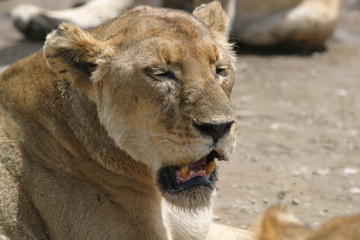New research on wild lions has revealed that males and females experience vastly different changes to their social network throughout their lives, and that this may shape their survival. The study offers new insight into the emerging topic of social ageing: how individuals change their social behaviour with age, and the consequences this has for other parts of their lives. This is the first time social ageing has been investigated in wild lions and across generations and sexes at the same time.

Lychee, a lioness included in the study. She was the oldest lion recorded in the Serengeti and lived to be 19 years old
Image: Craig Packer
Among cats, African lions (Panthera leo) are unique in the extent to which they depend on social acquaintances for many essential processes, such as hunting and rearing cubs. But until now, it was not known how individual lion’s social networks change as lions age and what this might mean for their survival.
This new study, based on 30 years of data on the Serengeti lion population, revealed several differences between sexes as they aged. For example, the strength of females' connections to males tends to be at its highest in mid-life, and then declines as they age. Whereas females' social connection to other females declines linearly with age, being highest in early adulthood.
On the other hand, males’ connection to other males is at its lowest in mid-life, then increases again as they age. Males social connection strength to females is highest in mid-life, and lowest in early and late life.
For females, social connectivity to their ‘friends’ is key for a long life, since females with stronger connections with their friends tend to live longer. For males, however, it is the raw number of friends which appears to be important for survival, since having a higher number of associates is associated with a longer lifespan. Lead author Lauren Rudd said:
"The importance of close female bonds, particularly in early adulthood, could be because 'friends' can help protect against threats such as infanticidal males. They could also be valuable allies for territory defence, hunting, and cub rearing - all of which require cooperation. Combined these factors potentially explain why better-connected females live longer."
The study was based on over 150,000 field observations of 665 individual lions, collected by the Serengeti Lion Project between 1984 and 2013. These recorded where, when and which lions were observed together on a daily basis. Lauren added:
"Understanding changes in sociality based on age and sex could help in predicting the dynamics of disease outbreaks in wild lion populations. For example, while ageing females’ may be less exposed to pathogens as their social connections decline, ageing males’ exposure risk could increase as they gain new associates."
Our current understanding of how, and why, individuals change their social behaviour as they age, and what consequences this social ageing may hold, is limited.
Further work in this lion system is now underway to investigate how the loss of 'friends' that an individual experiences as they go through their life might change their social behaviour and their position in their social network. The aim is to shed light on the mechanisms behind social ageing and provide insights into how the loss of some individuals may affect the remaining individuals in the population.
Going beyond this lion system, work in other wild animal societies is also beginning to investigate how the different sex roles might shape social ageing in other systems too, just as seen in the lion population. Co-author Dr Josh Firth said:
“Natural animal populations, where many individuals are being simultaneously monitored in detail across their entire lives and across many generations, offer unique opportunities to better understand social ageing and how this process operates across many different types of societies.”
To read more about this research, published in Current Biology, visit: https://doi.org/10.1016/j.cub.2024.07.040